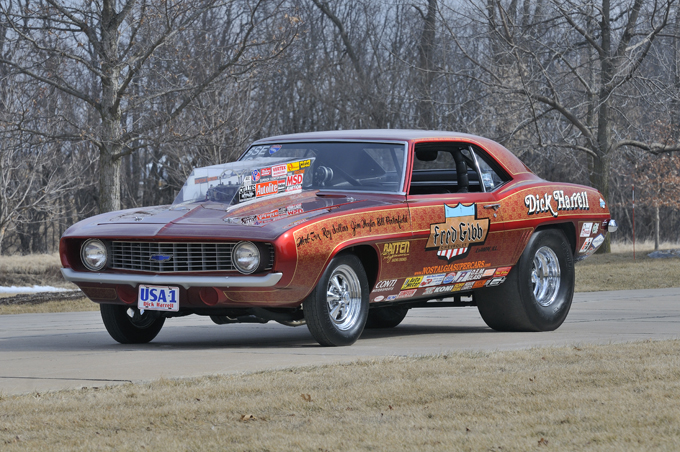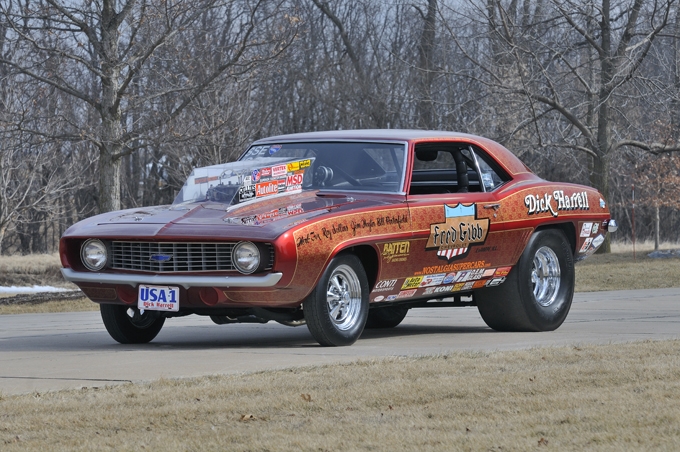
The first of a total of 69 ZL1 Camaros, the Gibb-Harrell car was born of an idea hatched by racer Fred Gibb and Chevrolet Product Promotions Manager Vince Piggins in 1968. Both wanted to run Chevrolet’s new all-aluminum Can-Am 427 engine in NHRA Super Stock drag racing.
Rules required that Chevy build 50 examples for the car to qualify for competition. Gibb committed to taking the entire minimum order of 50 cars. Piggins then activated the COPO ordering process, specifying that COPO 9560 add an all-aluminum 427 engine, cold-air induction, Harrison 4-core radiator, transistorized ignition, multi-leaf rear springs and a heavy-duty 4.10 12-bolt rear end.
The first and second ZL1 Camaros arrived at Fred Gibb Chevrolet covered in snow on New Year’s Eve 1968. The first car was immediately sent to Dick Harrell’s Kansas City, MO, shop, where Harrell readied it for its scheduled debut at the 1969 AHRA Winternationals three weeks later at Phoenix. Piloted by Gibb Chevrolet employee Herb Fox, the car beat the two top qualifiers before losing in the semifinal to eventual winner Arlen Vanke’s Barracuda. The most alarming part of the day for the Mopar contingent came when Fox eliminated Mr. Four-Speed himself, Ronnie Sox, in the Sox & Martin Hemi Barracuda.
Harrell demonstrated the car’s performance for Super Stock magazine in February 1969, turning 10.41 at 128.10 mph with the stock Holley 850, and 10.29 with dual 660 Holleys on a Weiand tunnel-ram. The Gibb-Harrell ZL1 Camaro then barnstormed the country, racking up victories in both AHRA and NHRA competition. In 1971, the car was converted to the new AHRA Pro Stock rules and driven by Jim Hayter, who set the AHRA Pro Stock record of 9.63 at 143 mph and won the AHRA Championship in both Super Stock and Pro Stock.
The car then disappeared into bracket competition for years until it surfaced in an ad in National Dragster in 1983. Oldsmobile engineer and ZL1 fanatic Bill Porterfield saw the ad and began a five-year pursuit of the car through two different owners, finally landing it in 1988. Porterfield then began the laborious task of restoring ZL1 Number One. This included building a correctly equipped Winters foundry ME-coded aluminum 427 rat motor, assembled entirely from authentic 1969 castings.
An astounding rarity, the Fred Gibb-Dick Harrell ZL1 Camaro pays homage to its creators, its history as a World Champion drag racing legend, and its status as Number One in the ZL1 lineage of classic COPO Camaros.
(Introductory description courtesy of Mecum Auctions.)
SCM Analysis
Detailing
| Vehicle: | 1969 Chevrolet Camaro ZL1 |
| Years Produced: | 1969 |
| Number Produced: | 69 |
| Original List Price: | $7,269 |
| SCM Valuation: | $300,000-$500,000 |
| Tune Up Cost: | $150 |
| Distributor Caps: | $19.99 |
| Chassis Number Location: | VIN plate on the instrument panel behind windshield |
| Engine Number Location: | Pad on front of block below right cylinder head |
| Club Info: | The Supercar Registry |
| Website: | www.yenko.net |
| Alternatives: | 1968 Dodge Dart Hemi, 1968 Plymouth Barracuda Hemi, 1969 Chevrolet Corvette L88 |
| Investment Grade: | A |
This ’69 ZL1, Lot F330, sold for $424,000, including buyer’s premium, at Dana Mecum’s 25th Original Spring Classic Auction on May 12, 2012.
The Gibb-Harrell ZL1 Camaro is not only the first ZL1 produced, but it is by far the most famous of the rare aluminum engine racers.
Earning its stripes
The Camaro was Chevrolet’s answer to the market-dominating Ford Mustang. Launched as a 1967 model, the car was a good seller in the showrooms of America, but it didn’t really earn racing “cred” until 1969, when two Camaros dominated their respective racing series — Mark Donohue’s Penske Racing Z/28 in Trans-Am, and the Gibb-Harrell ZL1 in Super Stock drag racing.
Donohue won the SCCA Trans-Am championship that year, and the Penske blue #6 was featured in numerous magazines and advertising campaigns. The Gibb/Harrell ZL1 did much the same in drag racing circles, and is equally revered in that sport. Arguably, these are the two most famous racing Camaros from any year.
Legendary power
COPO Camaros are rare cars, but the ZL1 is in a class by itself. There’s no arguing over what made this car so special. Chevrolet listed the ZL1 engine as producing 430 hp at 5,200 rpm with 450 lb-ft of torque at 4,400 rpm. But anyone who was humiliated by one of these cars knew better.
Fran Preve, historian of GM’s Tonawanda, NY, engine plant, unearthed the results of an original dyno test of a ZL1. According to him, the real numbers were 585 hp at 6,400 rpm with 510 lb-ft of torque at 4,800 rpm with headers and open exhaust. And that’s all in an engine weighing about the same as a 327 small block.
Light engines, heavy prices
In pre-recession 2005, ZL1 #18, possibly the only 4-speed ZL1 with its original engine, sold for an insane $840,000 — twice what any other ZL1 has sold for. More recently, ZL1 #63 from the Milt Robson Collection sold for $418k in 2010, while ZL1 #9 sold for $451k this past January. All of these are highly desirable, well-documented ZL1 Camaros, yet none has anywhere near the provenance of the Gibb-Harrell car.
But where vintage road-racing Corvettes with exceptional history have surpassed the $1,000,000 mark in recent years, and historic Trans Am series racers have sold for over $450,000, we have seen time and again that an equivalent drag racer will sell for less. Personally, I don’t care if a vehicle was victorious at Le Mans or at Lions Drag Strip — either way it has real history. But the market just doesn’t see it that way.
A screaming deal
If a less significant ZL1 can sell for over $400,000, shouldn’t the Gibb-Harrell Camaro have sold for much, much more? That’s a tough call, as the market is thin for real-deal drag race cars.
Would this car have brought more restored to its original off-the-truck configuration? It’s entirely possible, but the car’s history would have been lost in the process. Clearly, the restoration was driven by other factors than return on the investment — Porterfield was said to have searched across five states just to find the proper lace pattern for this car’s paint. If that’s not dedication, I don’t know what is.
There’s only one first ZL1, and I can’t blame Porterfield for making the decision to replicate the car’s most shining moment — its time at the hands of the racers who campaigned it, rather than the factory that built it.
At the price paid, I’d call this a screaming deal on one of the most important Camaros ever built.
It was purchased by a well-known California collector of muscle cars, who later said, “I bought it but I had no intention of buying it. The price was too low to not bid.”
I couldn’t agree more. 
